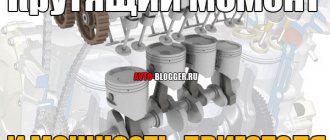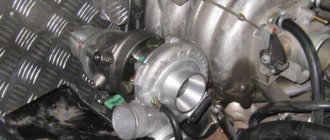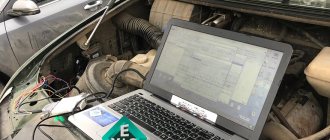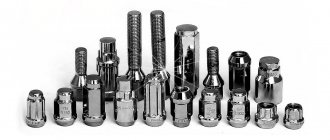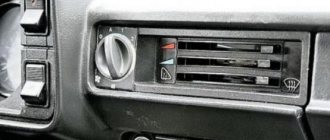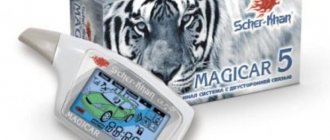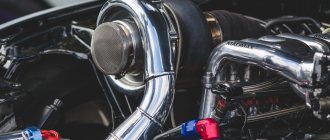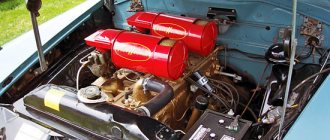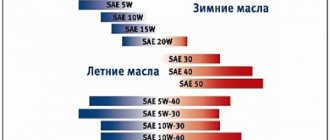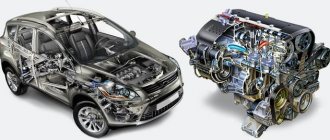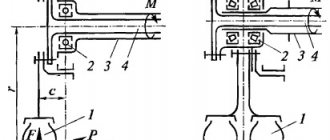Torque and horsepower
Car enthusiasts often debate with each other about whose engine is more powerful. But sometimes they have no idea what this parameter consists of. The generally accepted term "horsepower" was coined by inventor James Watt in the 18th century. He came up with it while watching a horse that was harnessed to a mechanism that lifted coal from a mine. He calculated that one horse could lift 150 kg of coal to a height of 30 meters in a minute. One horsepower is equivalent to 735.5 watts, or 1 kW is equal to 1.36 hp.
First of all, the power of any engine is assessed in horsepower, and only then do they remember the torque. But this traction characteristic also gives an idea of the specific traction and dynamic capabilities of the car. Torque is an indicator of the operation of the power unit, and power is the main parameter for performing this work. These indicators are closely related to each other. The more horsepower an engine produces, the greater the torque potential. This potential is realized in real conditions through the transmission and axle shafts of the machine. Connecting these elements together determines exactly how power can be converted into torque.
The simplest example is comparing a tractor with a racing car. A racing car has a lot of horsepower, but torque is required to increase speed through the gearbox. To make such a car move forward, very little work is needed, because the bulk of the power is used to develop speed.
As for the tractor, it may have an engine with the same displacement that produces the same horsepower. But in this case the power is used not to develop speed, but to generate traction (See traction class). To do this, it is passed through a multi-stage transmission. Therefore, the tractor does not develop high speeds, but it can tow large loads, plow and cultivate the land, etc.
In internal combustion engines, force is transmitted from the gases of the burning fuel to the piston, from the piston it is transmitted to the crank mechanism, and then to the crankshaft. And the crankshaft, through the transmission and drives, spins the wheels.
Naturally, engine torque is not constant. It is stronger when a greater force acts on the shoulder, and weaker when the force weakens or ceases to act. That is, when the driver presses on the gas pedal, the force acting on the shoulder increases, and, accordingly, the engine torque increases.
Power ensures overcoming all kinds of forces that prevent the car from moving. This is the friction force in the engine, transmission and drives of the car, aerodynamic forces, wheel rolling forces, etc. The more power, the greater the resistance of forces the machine will be able to overcome and develop greater speed. However, power is not a constant force, but depends on engine speed. At idle the power is the same, but at maximum speed it is completely different. Many car manufacturers indicate at what speed the maximum possible power of the car is achieved.
It must be taken into account that maximum power does not develop immediately. The car starts from a standstill at almost minimum speed (slightly above idle), and it takes time to mobilize full power. This is where engine torque comes into play. It will depend on it how long it will take for the car to reach its maximum power - that is, the dynamics of its acceleration.
Often the driver is faced with situations where it is necessary to give the car significant acceleration in order to perform the required maneuver. Pressing the accelerator pedal to the floor, he feels that the car is accelerating weakly. Fast acceleration requires powerful torque. It is this that characterizes the car’s throttle response.
The main force in an internal combustion engine is generated by the combustion chamber, in which the fuel-air mixture is ignited. It drives the crank mechanism, and through it the crankshaft. The lever is the length of the crank, that is, if the length is longer, then the torque will also increase.
However, it is impossible to increase the crank arm indefinitely. After all, then you will have to increase the stroke of the piston, and with it the size of the engine. At the same time, the engine speed will decrease. Engines with a large lever crank mechanism can only be used in large-sized boats. But in passenger cars with small crankshaft sizes you cannot experiment.
Physical definitions of engine power and torque
From the ninth grade physics course, we know that the torque M is equal to the product of the force F applied to the lever by arm length L. It is calculated by the formula: M = F * L.
The definition of motor power and the understanding of this parameter, established in science, is as follows: this is a physical quantity that characterizes the work the engine performs over a certain time. That is, power shows how quickly a car with a certain mass can cover a certain distance. The higher the power, the greater the maximum speed the car will develop with its curb weight remaining the same. In classical physics, power is measured in watts or kilowatts, and horsepower is a non-systemic unit of measurement.
Understanding torque is more difficult. Engine torque is a qualitative indicator that characterizes the rotational force of the engine crankshaft. It is calculated as the product of the force applied to the piston by the arm (i.e., the distance from the center of the crankshaft rotation axis to the piston attachment point (crankpin). Torque directly depends on the pressure force of the gases in the cylinder on the piston, as well as on the working volume engine and on the degree of compression of the fuel-air mixture in the cylinders.Diesel engines produce significantly higher torque - precisely because they have an extremely high degree of compression of the mixture of diesel fuel and air in the combustion chambers.
High engine torque gives the vehicle better acceleration dynamics, even at low crankshaft speeds, and significantly increases the traction characteristics of the engine: it increases the vehicle’s load-carrying capacity and its maneuverability.
Torque reaches its greatest value at certain speeds. Gasoline engines require more revolutions than diesel engines. Essentially, engine power is a secondary performance characteristic of the motor, which is a derivative of torque. It is linearly dependent on the crankshaft speed: the higher the speed, the greater the engine power (naturally, up to certain limits).
Torque also increases as engine speed increases. But, having reached its highest value (at a certain crankshaft speed), its performance begins to decrease, regardless of the further increase in speed.
What is engine power
In official descriptions of the technical characteristics of power units, in parallel with the indication of power, the value of torque is necessarily given. The concept of engine power and understanding of this parameter, as a rule, does not cause difficulties - it is a physical quantity that characterizes the engine work performed per unit of time. That is, power shows how quickly a car with a certain mass can cover a given distance. The more power, the higher the maximum speed with a constant curb weight.
Power is measured in watts or kilowatts (kW), as well as horsepower. It costs o - this is an off-system unit of measurement (1 horsepower = 735.5 W or 1 kW = 1.36 hp).
What is car engine torque in simple words
Torque and power of VAZ engines. As can be seen from the graphs, maximum power is achieved only at maximum revs, while peak torque is between 3000 and 4500 revs.
To answer this question in simple words, you must first find out what is meant by the terms “power”, “torque”, and also the number of revolutions. With the first of these characteristics the situation is somewhat simpler, since all those who studied well in high school know that power is the work produced per unit of time.
An internal combustion engine, consuming fuel, converts the thermal energy of its combustion into kinetic energy, while doing work. It consists of rotating the crankshaft, and this indicator is measured in revolutions per minute. Accordingly, the frequency with which the combustion of the fuel mixture occurs in the cylinders of the internal combustion engine directly determines the work performed by the engine and its power. This dependence is directly proportional.
As for torque, not everything is as obvious with it as with power and number of revolutions. It is, in fact, a quantity derived from them and represents the product of force on the lever arm. Since the force (in this case, the one that occurs during fuel combustion and acts on the piston) is measured in physics in newtons, and the length (in this case, the length of the crankshaft crank arm) is measured in meters, the unit of measurement for torque is Nm.
Thus, it turns out that torque is the force that the engine develops. It is its value that determines the traction force that ensures the acceleration of the car and its movement. Consequently, the greater the torque, the faster the car, which means the better its dynamics. Since the force acting on the piston during fuel combustion increases with increasing engine displacement, the larger it is, the higher the torque.
It should be noted that the characteristics of internal combustion engines always indicate the maximum power that they are capable of developing. Torque determines how quickly it is achieved and is therefore specified for a specific speed. In other words, it determines how quickly the power unit “selects” the power potential that is inherent in it by the designers. That is why, for example, when driving quite calmly at low speeds (up to 2500 rpm), for rapid acceleration, the most preferable engine is the one that has the maximum torque at them.
What does engine torque mean?
The components, systems, and complex mechanisms that make up a vehicle play an important role in the smooth operation of the vehicle. The internal combustion engine has the main function of providing energy for the movement of each element.
During its operation, as a result of fuel combustion, a force acts on the piston, then on the crank mechanism - the crankshaft. Then, from the output shaft of the power unit, power is transmitted through transmission elements to the chassis. Thanks to the transmitted torque, the wheels of the vehicle begin to move. With pressure on the gas pedal, the impact on the shoulder increases, which leads to an increase in this parameter.
Thanks to the stable operation of the internal combustion engine, the car can:
- Quickly reach the set speed.
- Change traction forces.
- Drive under various road conditions.
Torque is the determining parameter for assessing engine performance. Using this indicator, you can find out with what force the crankshaft spins. Engine torque is measured in units of newton meters and is calculated by the multiplication method: the force is multiplied by the distance from the crankshaft to the piston mounting point.
Engine power depends on microdistrict. Power calculation is carried out according to the formula: P = Mkr x n.
- P – engine power.
- Mkr – torque.
- n – crankshaft rpm.
What does engine torque depend on?
The indicator is not constant. In the power unit of an automobile or self-propelled vehicle, it depends on an increase or decrease in the force acting on the crankshaft. When acting on the throttle valve control mechanism (by pressing the gas in the vehicle cabin), the volume of the working mixture supplied to the combustion chamber changes.
As the mass of the working mixture increases, the force acting on the crankshaft increases. As the volume of the working mixture decreases, the force decreases. Thus, the torque is dependent on the force acting on the crankshaft of the power plant.
How does changing torque affect car dynamics?
To ensure the highest possible dynamic characteristics of the car, automakers are developing power units that have maximum torque over a wider range of engine speeds. High torque is typical for diesel engines, as well as multi-cylinder and turbocharged engines.
To really assess the role of power and torque in shaping the dynamic characteristics of a machine, the following must be taken into account:
- a car with a more powerful engine, but not having sufficient torque, will be inferior in acceleration dynamics to a car with less power but higher torque;
- high torque, which the engine is able to “pick up” already at low speeds, will allow the car to accelerate much more efficiently;
- the highest speed that a car can develop directly depends on the power of its engine, and torque, unlike acceleration dynamics, does not affect this indicator. The maximum speed of a car that has enormous torque may not be very high. For example, high-performance SUVs have a lot of torque and a low top speed, while racing cars may have little driveshaft torque but high speed.
Thus, regardless of the engine power, the accelerating dynamics of the car and its ability to climb inclines without problems depend entirely on what the maximum torque is. The more torque is transmitted to the drive wheels, and the wider the engine speed range in which it is achieved, the more confidently the car will accelerate and overcome difficult sections of roads.
It should be noted that a direct comparison of the characteristics of engines that are structurally identical, but have different torques, will only make sense if the parameters and transmissions are the same - when the gearboxes have similar gear ratios. If these parameters are different, then there is no practical point in comparing the torques and capabilities of the engines.
What does torque depend on?
The CM will be influenced by:
- Engine capacity.
- Cylinder pressure.
- Piston area.
- Crankshaft crank radius.
The basic mechanics of CM formation is that the larger the engine in volume, the more it will load the piston. That is, the KM value will be higher. The relationship with the radius of the crankshaft crank is similar, but this is secondary: in modern engines this radius cannot be changed much.
The pressure in the combustion chamber is an equally important factor. The force pressing on the piston directly depends on it.
To reduce torque losses when the car shakes during sharp throttle, you can use a compensator. This is a special (hand-assembled) damper, compensation of which will preserve torque and increase the service life of parts.
Torque for gasoline and diesel engines
Gasoline engines do not have the highest torque. The torque of a gasoline engine reaches its maximum value at speeds of no less than 3-4 thousand rpm. However, a gasoline engine can quickly increase power and spin up to 7-8 thousand rpm. At such ultra-high speeds, power increases significantly.
The diesel engine does not have high speeds. Usually this is 3-5 thousand rpm maximum, and here it loses to gasoline engines. However, the torque of a diesel engine is several times higher, and it becomes available very quickly, almost from idle.
As a specific example, we can recall tests of two engines from Audi - one diesel: 2.0 TDI with 140 hp. and a torque of 320 N.m, and the second petrol: 2.0 FSI with a power of 150 hp. and torque 200 N.m. Based on the results of a test run in various modes, it turns out that the diesel engine is as much as 30-40 hp. more powerful than a gasoline engine in the range from 1 to 4.5 thousand revolutions. That's why you shouldn't look only at horsepower. It happens that an engine with a smaller displacement, but with high torque, shows itself to be much more dynamic than an engine with a large displacement, but low torque.
In the technical specifications that are indicated for each car and its engine, the maximum torque is always indicated in combination with the speed at which such torque can be achieved. In this case, it is usually considered: if the maximum torque can be achieved at speeds up to 4.5 thousand rpm, then such an engine can be called low-speed; and if more than 4.5 thousand rpm - then high-speed.
At a low number of revolutions, a small amount of air-fuel mixture enters the combustion area per unit of time, so torque and power are low. By increasing the speed, the amount of the fuel-air mixture (and subsequently the power and torque) increases. Having reached significant parameters, power begins to decrease due to mechanical losses due to friction of mechanisms; inertial losses; from insufficient air injection (called oxygen starvation).
To ensure maximum amounts of air entering the combustion chamber, even at low engine speeds, electronically controlled turbocharging systems are used. By using such turbocharging systems, it is possible to ensure uniform torque characteristics over a wide range of engine speeds.
What conclusions can be drawn from the above?
When assessing the operational parameters of a car and the direct performance characteristics of its engine, the amount of torque will have a higher priority than power. Among engines that have approximately the same design and operating parameters, those with higher torque will be more preferable.
To ensure better acceleration dynamics of the car and ensure optimal traction properties of the engine, the crankshaft speed must be maintained in the range of values at which the torque can reach its peak performance.
As a result, we can conclude that classifying and comparing cars only by engine power (horsepower) is not entirely correct. It is also necessary to pay special attention to torque (N.m). If the engine torque is significantly higher than that of a similar or similar competitor in terms of performance characteristics, then such a motor will have greater dynamics.
An internal combustion engine develops its maximum power at certain speeds. For gasoline cars this is about 6 thousand rpm, for diesel cars it is less than 4 thousand rpm. That is why diesel engines, as a rule, belong to the low-speed class, and gasoline engines, to the high-speed class.
Low-speed turbocharged engines are best suited for city driving. If you want to compete in speeds on the highway, then it is better to choose a car with a high-speed power unit.
What is more important - power or torque?
When comparing the two main characteristics of the engine, the following points become clear:
- Torque is the main characteristic of the power unit;
- Power is a secondary characteristic that is a derivative of torque;
- Engine power directly depends on torque, which can be expressed by the formula: P= M* n , where
P – power, M – cool. torque, n – number of shaft revolutions per minute;
- The engine power depends on its rotation speed: as the number of revolutions increases, its power also increases (up to a certain limit);
- As the number of revolutions increases, the torque also increases, but when the maximum value is reached (at a certain speed), the indicator decreases even with its further increase.
Based on the comparative assessment, the following conclusions can be drawn:
- When assessing powertrain performance and vehicle performance, torque characteristics take precedence over power;
- Among similar engines, in terms of operating and design parameters, those with higher torque are more preferable;
- The best dynamics of vehicle acceleration and optimal engine thrust will be in a certain range of shaft rotation speed, which must be maintained while driving.
Ways to increase engine torque
The value required for the torque of a particular car model is determined by engineers at the preliminary stage of engine design development. Other elements of the car also depend on it: its suspension, braking and steering, aerodynamics. Therefore, before you start boosting the engine yourself, it is important to make sure that the car will not fall apart from overpowering the engine.
There can be many ways to increase torque and, with it, engine power:
- changing the geometric properties of the piston group;
- increased compression;
- replacing injectors or nozzles;
- installation of supercharging on a naturally aspirated engine;
- changes in the air intake system;
- modification or replacement of the exhaust system;
- chip tuning by reprogramming the fuel card of the engine control unit.
However, a forced increase in engine torque and power significantly reduces its service life.
How to accelerate correctly using maximum torque
To do this, it is important to know how to work with a gearbox. For maximum acceleration, you need to shift so that the revolutions drop approximately to the peak torque or above it, but so that there is a reserve for increasing the revolutions - acceleration above the maximum power revolutions will be slower. The ideal option for conventional cars is acceleration “from peak torque to peak power.” At the same time, on the engines of modern cars, the electronics simply will not allow the engine to be “overclocked” beyond its peak power - a “cut-off” will occur.
Torque meter
The main challenge in a torque meter using strain gauges is the accuracy of the data transfer. Previously used contact, induction and lighting devices did not guarantee the required efficiency. Nowadays data is transmitted via digital radio channels. The meter is a compact radio transmitter that is mounted on a shaft and transmits data to the receiver.
Now such devices are affordable and easy to use. They are mainly used in service stations.
